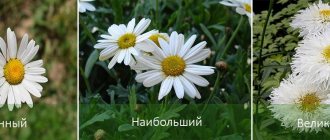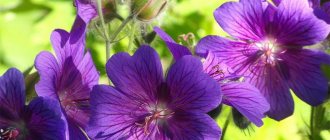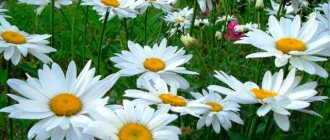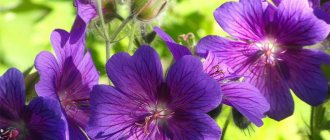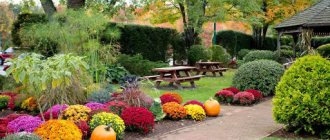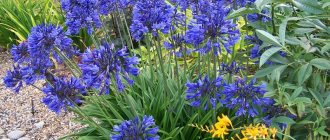Garden Tradescantia bushes help create beautiful voluminous thickets in the garden plot. Such bushes are planted close to ferns, daylilies, and irises. Tall varieties of perennials are recommended to be planted in dachas and gardens near water bodies.
Description of the plant
An adult plant looks like a small bush with a height of 0.2 to 1.00 meters with a large number of small beautiful flowers of white, blue, pink, lilac or purple.
- Tradescantia leaves are mostly bright green, lanceolate-elongated in shape, with an alternate arrangement. There are varieties with purple, yellowish or bluish foliage.
- The shoots are thin, knotty, and can be straight or groundcover.
- Tradescantia garden has thickened, fibrous roots.
- Umbrella-shaped inflorescences are located on the upper part of the peduncles and in the axils of the leaves.
- The flowers are small, up to 5 cm in diameter, with three petals, with unusually high, decorative stamens, this is clearly visible in the photo. Each flower lives for only a day, and is immediately replaced by the next one, so the flowering is abundant and does not stop from May until the October frosts. Faded flowers are not noticeable, since the petals of each of them turn into a gelatinous mass, reminiscent of a bud in shape. The plant retains its beautiful decorative appearance throughout the flowering period.
- The fruits of the garden Tradescantia look like a thin-walled box, consisting of two halves, inside which the seeds are hidden.
Preparing phlox for winter using shelter
Phlox is a relatively frost-resistant crop that can overwinter without shelter, growing in a mild continental climate. But even during warm winters, there are short-term severe cold snaps that can destroy the buds and roots of the plant: the fatal temperature for the above-ground part is -15 C, underground -20 C.
Not only severe frosts are dangerous for perennials, but also prolonged thaws: the plant reacts to heat and quickly opens buds, which suddenly freeze after sub-zero temperatures return. To protect the buds from possible frosts and prevent them from blooming during short-term warming, the plantings must be covered. Phloxes that do not have good cold resistance, as well as recently planted plants that have not yet had time to get stronger, especially need mulching. Covering phlox before winter is very simple: flowers prepared for winter are covered with a 10 cm layer of peat, compost or humus. In order to insulate one plant, it is necessary to scatter approximately one bucket of mulching material around the perimeter of the root system. To make the snow linger longer over the bush, mulch is covered with spruce branches and large tops. The cover should be removed in early spring, as soon as the risk of severe frost has passed.
Tradescantia is one of the most beautiful garden plants that blooms from May to September. The flowering of one inflorescence is short-lived, but since there are many of them, the bush always looks lush.
Types and varieties of Garden Tradescantia
For temperate latitudes, the most suitable types of Tradescantia are Tradescantia virginiana and, derived from it, Tradescantia Anderson. In turn, they also have their own subspecies:
- Tradescantia virginiana. The herbaceous evergreen plant forms bushes from 30 to 80 cm in height. The colors of the flowers are pink, blue, and sometimes white. It tolerates drought and frost well, does not require special lighting, and grows well in loose and moist soils. Cultivated in all regions of Russia. It has varieties with soft blue, bright red and pink flowers.
- Tradescantia Anderson. An erect bush up to 80 cm high. The leaves are violet-green, the color of the flowers can be white, blue, pink and purple.
- Tradescantia giant. It grows on rocky soil, the bush is low, up to 40 cm. It has wide leaves and terry-pubescent sepals.
- Tradescantia long-rhizome. Low bush, shoots up to 10 cm. Flowers pink or blue. It is easy to care for, drought-resistant and hardy.
- Tradescantia occidentalis. The height of the bush is up to 60 cm, the leaves are narrow and smooth. The flowers are pink or blue.
- Tradescantia Ohio. Bush up to 120 cm tall, with a whitish coating on the leaves, flowers of blue, pink or white with blue stamens.
- Tradescantia bract. Compact bushes up to 60 cm tall. The stems are smooth, the peduncles and sepals are pubescent, the flowers are blue or pink.
- Tradescantia subaspera. The stems of this subspecies are zigzag-shaped, reaching a height of 1 m. The flowers are blue.
- Tradescantia Ernestiana. The height of the bush is 1 m, the flowers are deep purple. Flowering occurs in spring.
Growing pains
The flowerpot is growing slowly. The problem can be detected by conducting an external inspection. The lashes of the flower are stretched, and the amount of green foliage on them decreases. The reason is poor watering and lighting, lack of microelements.
The burgundy leaves are turning green. There is not enough light.
The leaf blades are covered with yellow spots. There is not enough water.
The leaves have turned brown. The room in which the plant is located is low-humidity.
The leaves have lost their white stripes. Poor lighting, improper pruning and cuttings.
Choosing a landing site and conditions of detention
Tradescantia can grow in one place without transplanting for about 10 years, so it is better to immediately choose a suitable place for it in the garden.
The area should be illuminated in the morning and evening and in the shade at midday. Or you need to choose an area with diffused lighting throughout the day.
The planting site should be well protected from gusty winds and drafts, which can have a detrimental effect on the plant.
The occurrence of groundwater too close is also not desirable. If the plant is going to be planted near a pond, it is necessary to retreat a sufficient distance from the water's edge.
If the plant is supposed to be planted in an arid area, then it must be taken into account that it will need regular intensive watering.
The soil should be light, nutritious and slightly acidic, with a large admixture of organic matter. The best soil composition for planting garden tradescantia includes turf and leaf soil, sand and humus in equal parts.
Lighting
There are more than 30 species of saxifrage. Some of them are shade-loving; they need diffused lighting. Others, on the contrary, need a lot of light, for example, variegated Tradescantia.
If you are not sure which group your plant belongs to, place it in a window facing west or east. This arrangement will allow you to create an optimal light regime.
Planting tradescantia garden
Tradescantia is planted with seeds, divisions and rooted cuttings. It is better to plant cuttings and seeds in the spring, and cuttings in the fall. A plant grown from seeds blooms only after 3 years, so cuttings and divisions are most often planted.
Instructions for planting Tradescantia garden:
- The area chosen for planting is cleared of weeds, loosened and organic fertilizers are applied - vermicompost, peat, humus.
- Small grooves or holes are made in the soil, into which the seedling is placed vertically, straightening its roots.
- Cover the roots of the plant with soil so that the root collar is 2-3 cm below ground level.
- Then water the planted plant and mulch the root area of the soil with peat or humus.
- If the seedling was kept indoors before planting, it must be covered with covering material for several days so that it has time to take root well. Then the cover is removed.
- For tall varieties, it is necessary to provide the possibility of a garter or support.
- Every 5 years, it is advisable to divide a strongly overgrown Tradescantia into parts and replant it.
Autumn feeding of phlox
Fresh manure should not be applied to phlox; various rots may occur. The land intended for planting phlox must first be fertilized.
If the soil is clayey, then coarse river sand, gravel, wood ash, peat, compost are added. In order to fertilize 1 square meter of soil, 7 kg of peat, about 300 grams of wood ash, about 5 kg of humus or compost are required. All components are thoroughly mixed, river sand or fine gravel, 30 grams of nitrophoska, 30 grams of potassium sulfate and the same amount of Agricola-7 are added.
Then the fertilized soil is dug up again. Phloxes also like pine compost, although it is not available to everyone.
Features of caring for Garden Tradescantia
Tradescantia is a rather unpretentious plant, but for high-quality, abundant flowering and long-term preservation of its decorative appearance, it must be properly cared for.
Watering and loosening
Garden Tradescantia is a moisture-loving plant; it requires abundant regular watering, especially in the summer. During drought, it is recommended to spray the plant with rainwater from a sprayer in the evening.
In the fall, after flowering ends, watering is reduced, and in winter it is completely stopped.
The soil around the plant must be regularly loosened and weeds must be destroyed in a timely manner.
Top dressing
For rapid growth and long flowering, the plant must be fed with fertilizers. In early spring, before the start of the active growing season, they are fed with fertilizers such as Azofoska, Kemira, Nitroammofoska.
During the period when buds appear and before flowering, urea and ammonium nitrate are used.
In the fall, mulch the soil under the bushes with humus. All fertilizers are applied in the evening or morning in cloudy weather. If the land was fertilized before planting, then there is no need to fertilize it in the next 1-2 years.
Pruning and wintering
Periodically during flowering, it is recommended to remove faded inflorescences to stimulate abundant flowering. This is also done in order to prevent self-seeding and maintain the neat decorative appearance of the bush.
In the fall, after flowering has ended, the bushes are prepared for a dormant period - they are pruned at the root. The soil is mulched with peat, humus and moss to protect the roots from frost. In regions with harsh winters, it is necessary to cover the pruned plant with spruce branches and special covering material. These measures are also necessary for young plants; they must be mulched in a thick layer and then covered.
Replanting phlox in the fall
These plants can be planted or replanted in late spring, early autumn and even in summer (but not in hot weather).
In the fall, you cannot delay replanting because the plants will not have time to take root well before the onset of frost and will die. Transplanting phlox in the fall is most favorable in the period from the last ten days of August to mid-September, it is then that renewal buds are formed on the rhizome near the stems. In autumn, phlox should be planted with stems, but inflorescences and clusters with seeds should be cut off.
Late spring planting is fraught with the rapid onset of hot weather, which will also prevent phlox from developing well. Therefore, we must get down to business as soon as the ground thaws and is suitable for field work. Finally, if you still need to replant phlox in the summer, then this should be done on a cloudy day, and the plant should be replanted with a large lump of earth.
Pest control and disease prevention
Tradescantia garden is famous for its resistance to diseases, but if it is planted in the wrong place or has not been properly cared for, the plant may slow down and stop blooming. This happens when watering infrequently in the heat or when planting on soils flooded with water. The same troubles occur if the plant is planted in a completely shaded area or, conversely, in a place scorched by the sun all day.
Sometimes Tradescantia can be attacked by slugs and nematodes - microworms. When infected with nematodes, the plant must be cut off at the root and burned. To repel pests, gardeners plant marigolds, mustard and watercress next to Tradescantia.
Sometimes tradescantia attracts beetles - bronze beetles, which like to eat its stamens. They are combated by hand picking and spraying the plant with tinctures of aromatic herbs - tansy and wormwood.
Air temperature
Temperature cannot be called a key parameter for the favorable existence of saxifrage. The flower is quite resistant to both summer heat and winter cold.
However, this should not be taken literally. It is not advisable to intentionally expose saxifrage to extreme temperatures.
Methods for propagating Tradescantia garden
Tradescantia can be propagated in three ways: seeds, cuttings and division. Gardeners most often use division as the fastest and easiest way:
- In the spring, they dig up an adult bush and carefully divide it into several parts.
- Next, proceed according to the above-described planting scheme.
- Sometimes the entire bush is not dug up, but a part of the bush is simply separated with a shovel and taken out of the ground.
- Usually the survival rate of the cuttings is very good and after 2-3 months they are already blooming.
The next most popular method of propagating Tradescantia is by cuttings:
- Cuttings are prepared in spring or summer so that they become stronger by winter.
- The tops of the shoots with several internodes are cut off, the lower leaves are removed and placed in damp sand or water for several days until roots appear.
- Plant cuttings with roots in a container or shaded flower bed. After 1-2 months, with proper care and maintenance, the cuttings will be ready for planting in open ground.
The seed propagation method is usually used by breeders, since it requires too much time and action. In addition, varietal characteristics are not preserved with this method of propagation.
Sowing of seeds is carried out in winter or spring:
- Seeds are sown in containers with a light soil mixture and a drainage layer at the bottom. Sowing is done to a depth of about 2 cm.
- The containers are covered with film, thereby creating greenhouse conditions. The ambient temperature should be +24 degrees.
- It is necessary to regularly water the soil with seeds with water from a sprayer, loosen and fertilize it.
- After 2-3 leaves appear on the seedlings, they can be transplanted into open ground.
- Tradescantia grown from seeds blooms after 3 years.
Cuttings
Growing through cuttings is most convenient for the grower. There are no restrictions on the time of year. Here is the algorithm of actions: you need to carefully cut off several stems and plant them in containers (no more than five pieces in each). The roots will appear in a couple of days. To prepare the soil, you need to mix earth, humus and river sand in equal proportions.
If there is not enough time to plant the stems, they can be placed in a jar of water. This way they can be stored for several months. The main thing is to regularly replace the water and add fertilizer. But still, as soon as the opportunity arises, they need to be planted in a pot.
The use of tradescantia garden in landscape design
Tradescantia garden is widely used by landscape designers to create flower beds, flower arrangements, and design the coastal zone of reservoirs.
Tradescantia combines most successfully with ferns, irises, daylilies, geraniums, hostas, astilbes and heucheras.
Considering the need for shading in the middle of the day, it is planted in the low parts of alpine hills, near fences, in the shade of buildings.
When planting Garden Tradescantia, the possibility of lodging is taken into account, especially in tall varieties, and they try to plant plants nearby that will serve as good support for it.
Growing
In a container:
The plant's shallow and fast-growing root system needs a shallow, wide container. The soil mixture is prepared from leaf soil, humus and sand 2:1:1. Acceptable soil pH is 5.0–7.0.
Tradescantia should not be left in direct sunlight. It is advisable not to change the position of the pot relative to the light source: the plant does not tolerate rearrangement. Daylight hours should last eight to ten hours.
IN THE PHOTO: It is better to place the container with the plant on a window facing southeast or southwest. Photo by @zycie_szydelkiem_poplatane.
When there is a seasonal lack of lighting, artificial supplementary lighting is desirable. The more variegated the foliage of a specimen, the more light it will require to maintain its decorative appearance.
Tradescantia is suitable for moderately warm conditions during the period of active growth. During rest, the temperature drops to +16–20°C.
Tradescantia is moisture-loving, but the soil in its pot should not be flooded. Air humidity is maintained at 70–75%. The plant benefits from frequent spraying with softened water at room temperature.
It is fed with dry and liquid phosphorus-potassium fertilizers. Dry long-acting fertilizers are applied during transplantation. Liquid fertilizers are added to water for irrigation once every two weeks.
In open ground:
To grow garden Tradescantia, choose a place protected from direct sunlight and strong winds. The soil on the site should be loose and nutritious, with a high humus content.
Street Tradescantias do not like replanting and do not require it. They are grown in the same area for several years.
IN THE PHOTO: Curtain of Tradescantia. Photo by KENPEI.
Caring for Tradescantia in the garden is minimal. Like indoor specimens, when the air is dry, they are moistened from automatic watering systems. Plantings on the banks of reservoirs do not require watering or spraying. On poor soils, plants are regularly fed with fertilizers for decorative leafy garden crops.

